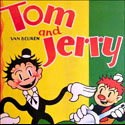
Paramount Pictures had a cartoon department for 40 years (from 1927 to 1967), but the studio has done everything it could to erase it’s animated past. It’s backlog of cartoons have been sold off throughout the years, and the subsequent owners have not been kind to the original presentation of these films.
FLEISCHER’S COLOR CLASSICS: U.M.&M. (and NTA see below) really abused the Fleischer negatives. They often placed hideous black bars to obscure all references to Paramount Pictures, Technicolor and the original copyright notice. In the early days of TV, the major movie studios distanced themselves from television. Television was considered the enemy of motion pictures, and the movie studios wanted to keep the theatre owners happy – by shunning the new medium. Thus, when older product was sold to TV, great pains were taken to remove reference to the original movie distributor. But U.M.&M. and NTA did it without any style… as shown in these actual NTA titles (below on the left) versus the original Paramount titles cards (on the right).

   
The COLOR CLASSICS series had a variety of different title treatments. The longest running was the “parchment style” (see DANCING ON THE MOON below) which was featured in 14 cartoons – from KIDS IN A SHOE (1935) to A CAR-TUNE PORTRAIT (1937). After that the titles varied slightly till the end of the series in 1940.

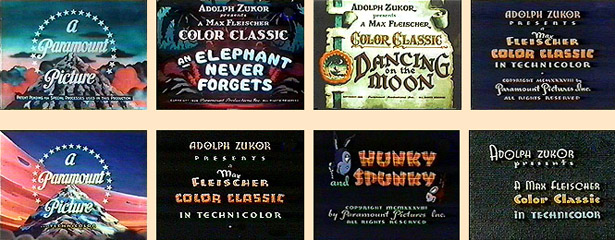  
 
   
Go behind the scenes at Fleischer Studios • Read a production draft for A CAR-TUNE PORTRAIT (Color Classic, 1937).

GULLIVER’S TRAVELS was chosen as the story by Max Fleischer. It had long been a favourite of his. Paramount did consider other topics, including Peter Pan, but Max’s choice prevailed. There was considerable difficulty working up a proper script and casting the film. An attempt was made to get Gary Cooper to do the voice for Gulliver. There is lots more that I could say about the production, but that’s too long a story. OK. GULLIVER’S TRAVELS went WAY over budget, and the studio became highly factionalized during its production. Personal and professional disputes between Max and Dave (revolving around Dave’s desire to have greater control over production and the music, and Max’s disapproval of Dave’s behaviour during an affair and subsequent divorce) led to the brothers not speaking to each other any more. Paramount was concerned about the drop in quality of shorts coming from the studio (the “Stone Age” cartoons in particular).

In order to obtain financing from Paramount for 1940-41 productions, the Fleischers had to provide Paramount with undated, signed letters of resignation from Fleischer Studios, Inc. (Famous Studios officially began on May 24th 1941 with Max Fleischer and Dave Fleischer as employees – one year later Paramount accepted their resignations) Production proceeded with MR. BUG GOES TO TOWN, which, unlike GULLIVER’S TRAVELS, came in on budget. The “Superman” cartoons were also quite successful. But because of the Consent Decrees, the release of MR. BUG GOES TO TOWN was held up, and because of the high cost of the “Superman” cartoons, it would take a long time for them to recover their costs. The studio was in a grave financial crisis, which they might have survived if Paramount had confidence in the management.

However, conditions between Max and Dave continued to deteriorate. Dave left the studio for New York, and Max sent a telegram to Paramount stating that he could not work with Dave anymore. Dave then signed with Columbia to supervise the production of “Screen Gems” cartoons. This put Paramount in an untenable position, as the co-owner of the company that was making Paramount’s animated films was also the head of production of cartoons for Paramount’s competitor. Paramount called their loan, which effectively bankrupted the Fleischer Studios. The letters of resignation were produced, and Max and Dave were no longer officers of the company. Sam Buchwald went to New York for emergency negotiations with Paramount, and a new company was formed under the partnership of Buchwald, Izzy Sparber, Seymour Kneitel and Dan Gordon called Famous Studios, which was to continue production of the films previously made by the Fleischers. Within a short period of time, Famous relocated from Miami back to New York (Dan Gordon left shortly after).

Some details of this can be found in an article that I wrote in Cinema Journal on the Standard Production Reference about ten years ago.” Paramount maintained a cartoon shorts unit in New York. First as a partnership called FAMOUS STUDIOS (from May 1942), then in full control (from Oct. 1956) as PARAMOUNT ANIMATION STUDIOS (through 1967). The Popeye cartoons were taken over by Associated Artists Productions (AAP), the remaining 1940s cartoons went to U.M.M. (later NTA, today Republic) and the 1950-1962 titles were sold to Harvey. Paramount still owns the 1962-1967 cartoons.
Original NOVELTOON opening: Here is an example of the original Noveltoon theatrical opening used from 1943 to 1955. These titles were replaced in the late 1950s by Harvey Comics. Noveltoons became Harveytoons, with a modified “jack-in-the-box” opening and closing title, and jumpcuts instead of dissolves during the opening credits. Click here to see original artwork (cel & pencil drawing) from this opening.
  
  

FEATURING: Each NOVELTOON cartoon opening title ended with a “Featuring…” card containing the star of that particular short. Here is the evolution of that title card art, with examples ranging from the mid-1940s through the mid-1960s.
   
   
  
   
   
   

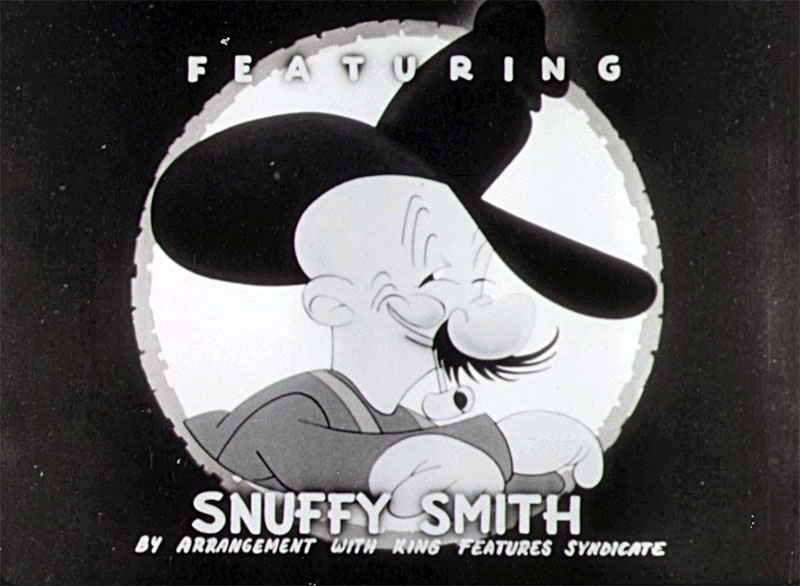
From “Spree For All” (1946)
PARAMOUNT in the 1930s
   
The Screen Songs often ended with a live action tag with the Paramount logo superimposed over it.

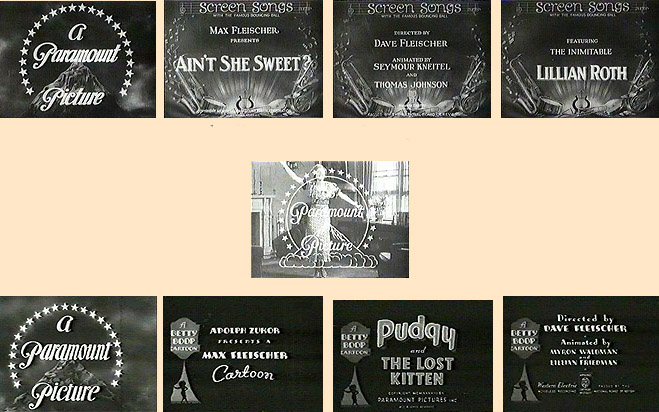
PARAMOUNT in the 1940s
   
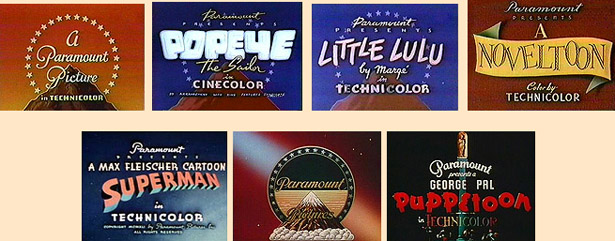
PARAMOUNT in the 1950s
   
   

PARAMOUNT in the 1960s


  
NTA and U.M.&M Prints

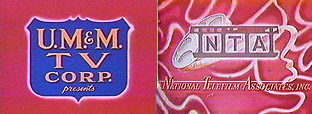
NTA is National Telefilm Associates, originally a TV distribution subsidary of 20th Centurty-Fox Film Corporation.
 Film editor Eric Albertson started his career at U.M.&M. – his first job was to replace the Paramount titles. He wrote me to explain: “I worked for UM&M, which was bought out by NTA in about 1957. That was Ely Landau’s company. The title replacement was done in 1954 & 55.
The color correction and the manufacturing of 16mm Eastman color negatives was done under my supervision at Pathe Labs. Some was also done at Tri-Art (Duart). Polarcolor, Magnacolor, True color, Technicolor, both two and three color separations.
Film editor Eric Albertson started his career at U.M.&M. – his first job was to replace the Paramount titles. He wrote me to explain: “I worked for UM&M, which was bought out by NTA in about 1957. That was Ely Landau’s company. The title replacement was done in 1954 & 55.
The color correction and the manufacturing of 16mm Eastman color negatives was done under my supervision at Pathe Labs. Some was also done at Tri-Art (Duart). Polarcolor, Magnacolor, True color, Technicolor, both two and three color separations.

 “You’re correct in that the replacement B/W logos were cut into the 35mm negative. We then made IPs and a reduction IN from that. We also made 32mm INs, and 35/32mm INs. For Technicolor we made 35mm IPs from the separation negatives and reduction Eastman Color INs from those. All the above work was done at the old Pathe Labs in New York. For Polar Color, Magna Color, etc, we did most for the work at DuArt in New York, and some at Movielab who had developed the octet printer. One pass of the negative gave you eight prints.
All materials were ultimatly stored at Bonded Storage in NY.”
“You’re correct in that the replacement B/W logos were cut into the 35mm negative. We then made IPs and a reduction IN from that. We also made 32mm INs, and 35/32mm INs. For Technicolor we made 35mm IPs from the separation negatives and reduction Eastman Color INs from those. All the above work was done at the old Pathe Labs in New York. For Polar Color, Magna Color, etc, we did most for the work at DuArt in New York, and some at Movielab who had developed the octet printer. One pass of the negative gave you eight prints.
All materials were ultimatly stored at Bonded Storage in NY.”
In film collecting circles, a common expression when gauging an old print’s color condition is “NTA Red”. That’s because old color prints of cartoons with NTA logo have faded to beet-red, washed out to pink. The chemical process used didn’t hold color well – unfortunetly that means that existing copies of many Fleischer Color Classics, George Pal Puppetoons, Famous Novetoons and Little Lulu films are today in very poor shape.
Reader Glenn G. sent in this info about NTA: “My great uncle worked for National Telefilm Associates (NTA) for many years. I mentioned to him once that a lot of the TV prints I’d seen of color UM&M/NTA cartoons were very reddish. He told me that part of that was probably because of fading due to Eastmancolor’s instability. That I knew. What I didn’t know was this: in the 1950s and well into the 1960s, it was customary, when 16mm prints were being made up for broadcast television use, to accentuate the red in the printing process. He said that was necessary to make those color prints “read correctly” on the black & white equipment in use back then.
He also told me that NTA originally made up prints from the same negatives UM&M had prepared in the 1950s. NTA just replaced the old logo on the negative.
Another thing he told me was that in the 1970s NTA finally started making up new television negatives for those cartoons, but by then, there wasn’t much interest in them by local stations, in part because of the large number of black & white titles — he said trying to sell B&W cartoons after TV went all-color was futile — and in part because there weren’t a lot of cartoons with “big name” characters, such as Bugs Bunny or Popeye.”

SPECIAL END TITLES: Famous Studios occasionally did a special “end title” which would incorprate the Paramount logo into the cartoon. These were cut out when Popeye cartoons were sold to A.A.P. and others cartoons were sold to Harvey and U.M.M. TV Corp.
ALPINE FOR YOU and POPEYE THE ACE OF SPACE (1953 – see end title successive frames at bottom of this page) are two unique Popeye cartoons – both of which have been recently restored on Cartoon Network.
PEDRO AND LORENZO (1956) ends with a storybook closing, the Paramount logo on the back cover.
RABBIT PUNCH (1955) has a special ending where Tommy Tortoise pulls the Paramount mountain closing credits from boxing canvas to full screen then walks in front of it.
NO IF’S ANDS OR BUTTS (1954) starring “Buzzy, The Funny Crow” also featured a special ending.
Considering this cartoon features Buzzy, a black crow, and the cartoon centers around smoking, I doubt we’ll see this on television ever again. And the original end title has been missing for years.
Thanks to Cartoon Research detective Milton Knight we are pleased to present the original end title to this cartoon. Buzzy takes a drag on a “King size!” cigarette, blows the smoke into the air, revealing the Paramount logo. Very Kool!
 

Below: 35mm frame of original end title from RIOT IN RHYTHM (1950)

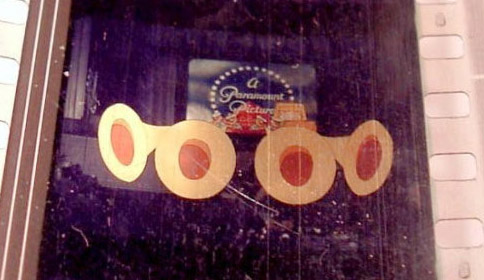
Below: original end titles from POPEYE THE ACE OF SPACE (1954)
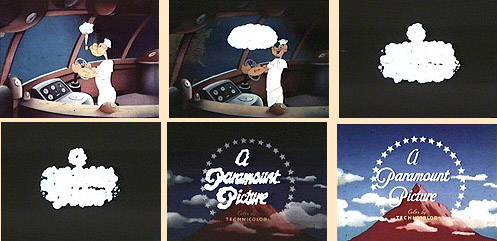
Written, compiled and copyright © 2013 by Jerry Beck
Special thanks to Ken Layton, Fred Grandinetti and Mark Kausler for contributing to this page.
Return to ORIGINAL TITLES home page


 Jerry Beck is a writer, animation producer, college professor and author of more than 15 books on animation history. He is a former studio exec with Nickelodeon Movies and Disney, and has written for The Hollywood Reporter and Variety. He has curated cartoons for DVD and Blu-ray compilations and has lent his expertise to dozens of bonus documentaries and audio commentaries on such. Beck is currently on the faculty of CalArts in Valencia, UCLA in Westwood and Woodbury University in Burbank – teaching animation history. More about Jerry Beck [
Jerry Beck is a writer, animation producer, college professor and author of more than 15 books on animation history. He is a former studio exec with Nickelodeon Movies and Disney, and has written for The Hollywood Reporter and Variety. He has curated cartoons for DVD and Blu-ray compilations and has lent his expertise to dozens of bonus documentaries and audio commentaries on such. Beck is currently on the faculty of CalArts in Valencia, UCLA in Westwood and Woodbury University in Burbank – teaching animation history. More about Jerry Beck [







